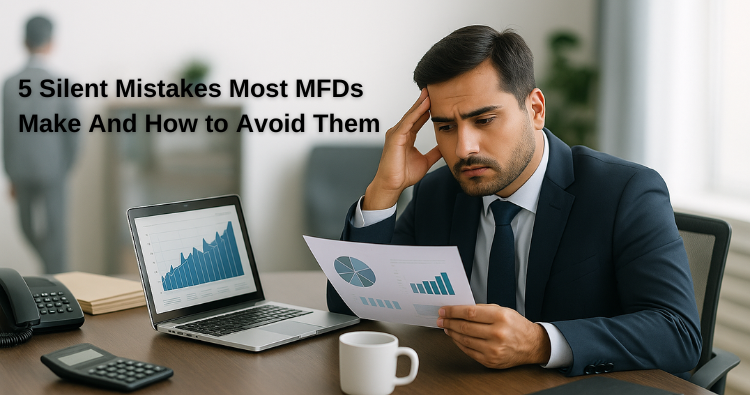
5 Silent Mistakes Most MFDs Make And How to Avoid Them
Mutual Fund Distributors are the vital bridge between financial products and investors. They don’t just process investments—they play a crucial role in guiding decisions that shape clients’ financial futures and overall confidence in wealth creation. Every interaction, suggestion, and follow-up from an MFD has the power to build trust and long-term relationships. However, in the constant race to acquire more clients and scale their business, many MFDs unknowingly fall into patterns that become silent mistakes, even though they don’t appear serious at first glance.
These are not obvious errors like mis-selling or breaking rules. Instead, they are small habits—like focusing only on transactions, avoiding technology, or not communicating enough. Over time, these weaken trust and limit growth. If ignored, they make it harder for MFDs to stand out in a market full of choices, where investors may prefer robo-advisors or online platforms. By fixing these small mistakes early, MFDs can build trust, improve reputation, and ensure steady growth.
This blog dives deep into five of the most common silent mistakes MFDs make and practical strategies to avoid them.
Mistake 1: Focusing Only on Selling, Not Advising
Many MFDs focus heavily on selling products rather than truly advising clients. This transactional approach may work in the short term, but it weakens long-term relationships. Clients today don’t just want someone to process investments, they want a partner who understands their goals, risks, and provides guidance beyond product recommendations. When MFDs only sell, clients may feel undervalued and look elsewhere for genuine advice.
How to Avoid
Shift your approach from product-selling to goal-based financial planning. Understand your client’s life goals—whether it’s retirement, education, or wealth creation—and design portfolios that align with those needs. By acting as an advisor rather than just a distributor, you’ll build deeper trust and loyalty.
Mistake 2: Ignoring Technology and Digital Tools
In a world where investors manage everything from banking to shopping on their phones, relying only on traditional methods is a silent but serious mistake. Many MFDs still use manual processes or avoid digital platforms, which slows down operations and creates a poor client experience. This not only frustrates clients but also makes the business look outdated and less professional. Tech-savvy competitors or robo-advisors then step in and capture this gap, positioning themselves as smarter and more efficient alternatives.
How to Avoid
See technology as a helper, not a danger. Use apps to track portfolios, simple CRM tools, robo-advisory support, and online onboarding to work faster and smarter. When clients notice that you’re using modern tools to make their experience easier, it builds both their trust and satisfaction.
Mistake 3: Underestimating the Power of Communication
Some MFDs communicate with clients only when a transaction is needed or when markets crash. This reactive communication creates uncertainty and leaves clients feeling ignored. In the absence of regular updates, clients may turn to online platforms or competitors for clarity. Lack of consistent communication gives the clients the impression that their advisor is not actively monitoring their portfolio, which can damage trust over time.
How to Avoid
Communication should be proactive and consistent. Share regular portfolio updates, market insights, newsletters, or even simple WhatsApp messages. Explain complex changes in simple terms. By staying visible and approachable, you reassure clients that you’re always working in their best interest.
Mistake 4: Neglecting Continuous Learning and Compliance
The investment world changes quickly—new regulations, tax rules, and fund options appear regularly. An MFD who doesn’t keep learning may unknowingly give outdated advice or miss new opportunities. Worse, ignoring compliance updates can lead to penalties and harm professional credibility. Clients expect their advisor to be up to date with latest changes, and failures to do so makes them question the advisor’s expertise and reliability.
How to Avoid
Treat learning as a continuous responsibility. Attend AMFI/SEBI training programs, follow industry news, and update your knowledge on tax-efficient investing. Staying compliant and updated not only protects your business but also boosts your credibility with clients.
Mistake 5: Overlooking Relationship Building
In the race to meet sales targets, many MFDs forget that relationships are the backbone of long-term success. Clients don’t just remember what you offered—they remember how you made them feel. If the relationship feels purely transactional, they are less likely to stay loyal or recommend your services.
How to Avoid
Focus on building genuine personal connections. Understand your client’s concerns, celebrate their milestones, and support them in times of uncertainty. By becoming a trusted financial partner and showing empathy. You strengthen loyalty and improve client lifetime value.
Conclusion
Silent mistakes may not seem obvious, but over time they can limit growth and weaken client trust. The good news is that each mistake can be avoided with small, consistent changes. By moving from selling to advising, embracing technology, communicating proactively, learning continuously, and building strong relationships, MFDs can stand out in a crowded market.
In the end, true success as an MFD doesn’t come from just distributing funds—it comes from being a guide, a partner, and a trusted advisor who adds real value to every client’s financial journey.
Request for AnchorEDGe Subscription to Grow your AUM and business